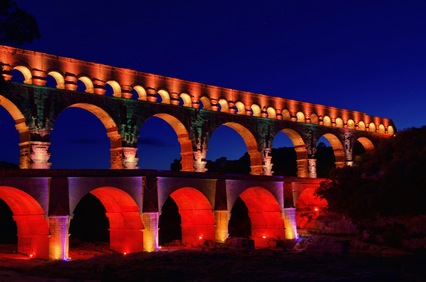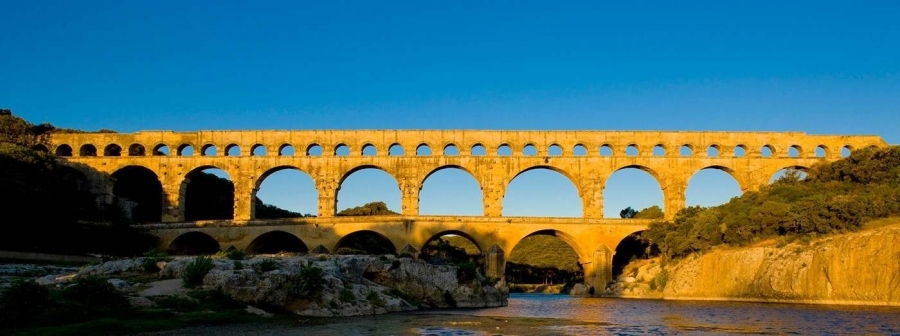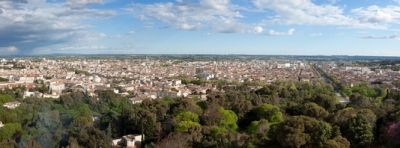World Heritage
The Nîmes aqueduct is one of the oldest and most remarkable works that the hydraulic engineers installed and multiplied in all parts of the Roman Empire during the conquests. A masterpiece of Roman art, the Pont du Gard is one of the most important monuments for understanding the construction processes of the early imperial period. The accuracy of the construction matches the perfection of a technologically demanding design; indeed, since the 16th century the Pont du Gard has been considered a major reference of Roman civilization. An outstanding achievement, the Nîmes aqueduct, which traverses the Gardon River, provides a unique testimony to the skill of the technical engineers and builders of the Roman Empire. The sight of the monument leaves a grandiose impression, one that many writers have since immortalized.
The dimensions of the Pont du Gard make it the highest construction built by the Romans. Similarly, the arches on the first two levels are the most daring structures ever built in stone. Its appearance, extraordinarily light for a building of this magnitude, still amazes visitors.
It is apparent that the Pont du Gard very quickly became a source of inspiration for other regional construction projects. From the Middle Ages onward, traces of its imitation, such as the bridge of Avignon in particular, all have the same type of vault with alternating arches.
Criteria for selection
The Pont du Gard has been listed by UNESCO as a World Heritage site since 1985, at which point the site was, and has remained, globally recognized.
Criterion (i): a masterpiece of human creative genius.
Criterion (iii): unique and exceptional testimony to Roman civilization.
Criterion (iv): an outstanding example of Roman construction, as well as of architectural ensemble and technique, the aqueducts illustrate a significant stage in the history of humanity: the Roman period.
Source : UNESCO / ICOMOS
History
History of the Pont du Gard
The bridge
The Pont du Gard is an aqueduct built by the Romans in the 1st century AD. At an exceptional 49 meters high, it is the highest Roman aqueduct in the world. It is the only example of ancient, 3-level bridge still standing today (at its origin and still today, there were 6 arches on the first level, 11 on the second level and 47 small arches at the top).
The bridge is especially remarkable for its excellent state of preservation. No mortar was used to bond the blocks together (weighing between 6 and 8 tons each!), which is what allows it to have a certain elasticity and resist the forces of the elements. Nearly a thousand men worked on this huge project, completed in just five years.
The aqueduct
Built around 50 AD, under the reign of Claudius or Nero, the aqueduct (to which the Pont du Gard belongs) had supplied the city of Nîmes pressurized water in large quantities for five centuries. This Roman city, called "Nemausus," had developed so much during the 1st century that it was decided to build an aqueduct like Rome, the capital and model for the entire Roman Empire.
This achievement gave the city (which then had 20,000 inhabitants) new prestige : fountains, baths and running water in the grand houses contributed to the comfort and well-being in the city. With an average slope of 34 centimeters per kilometer, among the flattest ever made at that time, the aqueduct transported 30 to 40,000 m3 of running water per day from a source located in Uzès, 50 kilometers from Nîmes. The water channel, covered with a roof, was 1.35 meters wide. Underground and located in trenches (or tunnels) for 90% of its course, the channel was supported for the rest by structures adapted to all types of crossings. The 19 above-ground elements constitute 10% of the aqueduct. Some of these buildings are still visible along the route from Uzès to Nîmes and 9 of them are on the Pont du Gard site, upstream and downstream from the bridge.
It ran at full speed until the 4th century, but due to a lack of maintenance, the channels were progressively clogged by limescale (calcium build-up). The people of Nîmes, having found closer water sources, had completely abandoned it by the 9th century. Part of its stones and slabs eventually looted for reuse in buildings around the area (houses, churches). It later became a road bridge, requiring a toll to cross.
Tourist Office
Pont du Gard Tourist Offices
Pont du Gard Tourist Office
Bureau de Remoulins
Place des Grands Jours, 30210 Remoulins
Website - tel : 04 66 37 22 34.
Opening time:
Mid-April through October, Tuesday to Friday: 10 a.m. to 1 p.m./ 2 p.m. to 6 p.m., Saturday: 10 a.m. to 1 p.m.
Accommodation available for visitors with disabilities.
Pont du Gard (Site grounds)
La Bégude
400 route du Pont du Gard
, 30210 Vers-Pont du Gard
Website - tel : 04 66 37 50 99
3 pass are available with or without the guided tour of the Pont or the pipeline.
Full / reduced price: €9.50 / €7. Free - 18 years old.
Evening price in July and August to admire the lighting of the bridge in July and August, full price/ reduced price: €5/ €3. Free - 18 years old.
Guided tour +€6/pers.
Open every day:
November through March: 9 a.m. to 6 p.m.;
April and October: 9 a.m. to 8 p.m.
May: 9 a.m. to 9 p.m. ;
June and September: 9 a.m. to 10 p.m.;
July and August: 9 a.m. to 11 p.m.
Accommodation available for visitors with disabilities. Wheelchairs available.
Guarded parking, open from 7 a.m. to 1 a.m. The price of the parking is included in the price.
Visioguide rentals in 8 languages: € 4.
Booklet "Treasure Hunt" for children from 7 years old. Baby changing station (on the left bank).
App "Pont du Gard Tour" to download for free from the Apple Store or Google Play.
Museum
The Museum
Very interesting and well done, the museum traces the history of the bridge and the aqueduct. Models, virtual reconstructions, multimedia displays, and soundscapes all contribute to the discovery of Roman antiquity.
The multi-screen helps visitors immerse themselves in the heart of the city of Nîmes. Between past and present, the show presents the role of water through several scenes of everyday life, combining video, sounds, and illustrations of the ancient and modern city.
Tour "Le chantier de l’aqueduc” (the construction of the aqueduct): discover the construction of this masterpiece, combining art and technology.
Events
Main events of the year at the Pont du Gard
Les fééries du Pont (early June)
A great show sound, light, pyrotechnics and video-morphing, magnifying the Pont du Gard.
Rendez-vous at the river
From mid-June, beaches are installed on the right bank of the Gardon River, 200 meters from the bridge.
Planned for children: they can play in the specially equipped recreational area and swim in a supervised zone on the beach.
Entertainment, tours (July to mid-August)
Daily tours are offered for visiting the water channel on the 3rd level of the bridge, with an exceptional view over the Gardon valley.
Lighting of the bridge
During the summer evenings visitors can enjoy the lighting of the monument, a magical moment. Many events are held here throughout the year. See the schedule of events directly on the website.

Transport
Access to the Pont du Gard
The Pont du Gard is located between Remoulins (Highway RN 100) and Vers-Pont du Gard (Highway D 81).
By car
Highway A9, exit 23 Remoulins, direction Uzès, then follow the signs to the right bank or the left bank.
Nearby classified sites:
Avignon: 27 km (16.5 mi), time: 30 minutes
Orange: 30 km (18.5 mi), time: 25 minutes
Arles: 39 km (24 mi), time: 55 minutes
Causses and Cévennes (Saint Jean du Gard): 70 km (43.5 mi), time: 1 hour, 20 minutes
By Bus (from Nîmes and Avignon)
Nîmes Bus Station
530 Avenue Robert Bompard
, 30000 Nîmes
Website - tel : 08 10 33 42 72.
Avignon Bus Station (next to the railway station)
5 Avenue Monclar, 84000 Avignon
Tel : 04 90 82 07 35.
By Plane
Nîmes-Arles-Camargue Airport (25 km)
Website - tel : 04 66 70 49 49. No schuttles.
Avignon-Caumont Airport (43 km)
Website - tel : 04 90 81 51 51.
By train
Nîmes and Avignon Train Stations by the TGV. TGV Paris-Nîmes (2 hours, 50 minutes), Paris-Avignon (2 hours, 40 minutes).
Avignon TGV Station (3.5 km from the city center)
Area of the curtain, 84000 Avignon
Website - tel : 36 35.
Nîmes SNCF Train Station
1 Boulevard Serge Triaire,
30000 Nîmes
Website - tel : 36 35.
Avignon Centre SNCF Train Station
Boulevard Saint-Roch, 84000 Avignon
Website -
tel : 36 35.
Regional connections.
Sleeping / Eating
Hôtels around Pont du Gard
The selection of accommodation proposed below consists of establishments that offer quality services at competitive rates, they are considered as references in their respective categories. These addresses are located nearby the bridge. The prices shown are for the off season, on the basis of 2 people.
Hostellerie Le Castellas ****
30 Grand Rue, 30210 Collias
Website - tel : 04 66 22 88 88
Room from €95.
Gourmet Restaurant:
"Lunch Fromule" from €19. "Dinner" from €46.
Hôtel Le Gardon ***
9 Rue de Campchesteve, 30210 Collias
Website - Tel: 04 66 22 80 54.
Price from €78.
Hôtel La Bégude Saint Pierre ****
295 Chemin des Bégudes, 30210 Vers-Pont-du-Gard
Website - Tel: 04 66 02 63 60.
Room from €127.
Gourmet Restaurant:
"Lunch Fromule" at €26. "Dinner menu" from €46.
Restaurant on site
Restaurant Les Terrasses - Mediterranean cuisine
Tel: 04 66 63 91 37.
Menu €25.90.
Snacks also avalaible on site.






